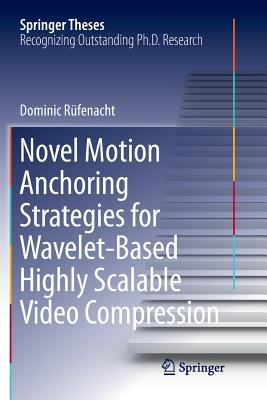Novel Motion Anchoring Strategies for Wavelet-Based Highly Scalable Video Compression
暫譯: 基於小波的高可擴展視頻壓縮的新穎運動錨定策略
Rufenacht, Dominic
- 出版商: Springer
- 出版日期: 2019-01-10
- 售價: $4,570
- 貴賓價: 9.5 折 $4,342
- 語言: 英文
- 頁數: 208
- 裝訂: Quality Paper - also called trade paper
- ISBN: 9811340978
- ISBN-13: 9789811340970
-
相關分類:
數位影像處理 Digital-image
海外代購書籍(需單獨結帳)
相關主題
商品描述
A key element of any modern video codec is the efficient exploitation of temporal redundancy via motion-compensated prediction. In this book, a novel paradigm of representing and employing motion information in a video compression system is described that has several advantages over existing approaches. Traditionally, motion is estimated, modelled, and coded as a vector field at the target frame it predicts. While this "prediction-centric" approach is convenient, the fact that the motion is "attached" to a specific target frame implies that it cannot easily be re-purposed to predict or synthesize other frames, which severely hampers temporal scalability.
In light of this, the present book explores the possibility of anchoring motion at reference frames instead. Key to the success of the proposed "reference-based" anchoring schemes is high quality motion inference, which is enabled by the use of a more "physical" motion representation than the traditionally employed "block" motion fields. The resulting compression system can support computationally efficient, high-quality temporal motion inference, which requires half as many coded motion fields as conventional codecs. Furthermore, "features" beyond compressibility -- including high scalability, accessibility, and "intrinsic" framerate upsampling -- can be seamlessly supported. These features are becoming ever more relevant as the way video is consumed continues shifting from the traditional broadcast scenario to interactive browsing of video content over heterogeneous networks.
This book is of interest to researchers and professionals working in multimedia signal processing, in particular those who are interested in next-generation video compression. Two comprehensive background chapters on scalable video compression and temporal frame interpolation make the book accessible for students and newcomers to the field.
商品描述(中文翻譯)
任何現代視頻編解碼器的一個關鍵要素是通過運動補償預測有效利用時間冗餘。在本書中,描述了一種在視頻壓縮系統中表示和使用運動信息的新範式,這種範式相較於現有方法具有幾個優勢。傳統上,運動是在其預測的目標幀上作為向量場進行估計、建模和編碼的。雖然這種「以預測為中心」的方法很方便,但運動「附著」於特定目標幀的事實意味著它無法輕易地重新用於預測或合成其他幀,這嚴重妨礙了時間可擴展性。
鑑於此,本書探討了將運動固定在參考幀上的可能性。所提出的「基於參考」的固定方案成功的關鍵在於高質量的運動推斷,這是通過使用比傳統的「區塊」運動場更「物理」的運動表示來實現的。由此產生的壓縮系統可以支持計算效率高、質量優良的時間運動推斷,這需要的編碼運動場數量僅為傳統編解碼器的一半。此外,除了可壓縮性之外的「特徵」——包括高可擴展性、可訪問性和「內在」幀率上採樣——也可以無縫支持。隨著視頻消費方式從傳統的廣播場景轉向在異構網絡上互動瀏覽視頻內容,這些特徵變得越來越相關。
本書對於從事多媒體信號處理的研究人員和專業人士特別感興趣,尤其是對於下一代視頻壓縮感興趣的人士。兩個關於可擴展視頻壓縮和時間幀插值的綜合背景章節使本書對於學生和新手更具可讀性。
作者簡介
From 2011 to 2013, he was with the Image and Visual Representation Group (IVRG) at EPFL as a research engineer, where he was working on computational photography problems, with emphasis on near-infrared imaging. He currently holds a post-doctoral position at UNSW Sydney, working on next-generation video compression systems. His research interests are in computational photography and highly scalable and accessible video compression, with a focus on temporal scalability.
作者簡介(中文翻譯)
Dominic Ruefenacht 於 2009 年和 2011 年在瑞士洛桑聯邦理工學院 (École Polytechnique Fédérale de Lausanne, EPFL) 獲得通信系統的學士和碩士學位,專攻「信號、影像與介面」。他曾是加拿大安大略省滑鐵盧大學的交換學生,並在荷蘭埃因霍溫的飛利浦消費生活部門完成碩士論文。他於 2017 年在澳大利亞新南威爾士大學 (UNSW Sydney) 獲得博士學位,研究主題為「基於小波的高度可擴展視頻壓縮的新型運動錨定策略」。
從 2011 年到 2013 年,他在 EPFL 的影像與視覺表現組 (Image and Visual Representation Group, IVRG) 擔任研究工程師,專注於計算攝影問題,特別是近紅外成像。目前,他在新南威爾士大學擔任博士後研究員,研究下一代視頻壓縮系統。他的研究興趣包括計算攝影和高度可擴展且可訪問的視頻壓縮,特別關注時間可擴展性。












